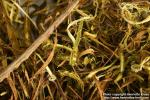It doesn't have to be the root or the root bark.
If the branches of your barberry (Berberis spp.) bushes have bright yellow bark it'll work as well as the root or root bark.
A plus is, you don't have to dig the bush up. Which means that one or two largish bushes will supply an ample amount of branch bark, as opposed to the "gotta plant half a dozen or so, so I can dig one up every couple years".
A minus is, you'll have to cut the very sharp spines along the branches before you can start stripping the bark off. Or you could of course leave them on, but then you'd prick yourself every time you used some barberry branch bark.
 Pic: Bark of Berberis branches. Some of the branches we peeled day before yesterday were a very deep yellow almost down to the soft center bits. Those yellow branches I sliced up and added to the peeled bark, to dry.
Pic: Bark of Berberis branches. Some of the branches we peeled day before yesterday were a very deep yellow almost down to the soft center bits. Those yellow branches I sliced up and added to the peeled bark, to dry.
Pretty, no?
--
Related entries: Berberis tincture - Berberis tincture update - Signatures


Comments
You have a preference in
You have a preference in regards to the bark gathered in the fall or spring? Think there's a substantial difference, or just use the yellow-ness as your potency indicator?
Berberine is yellow. The
Berberine is yellow. The action of Berberis is more or less that of berberine. Therefore, the yellower the bark the better.
I haven't (yet) seen spring bark, so can't compare it to fall bark.
I have done this with Oregon
I have done this with Oregon Grape (B. aquifolium) in the spring and it made a very potent tincture. However, a piece of bark sticking above the alcohol (oops) started to mold.
Normally I harvest B. nervosa, a low growing species. We take the root and replant the tops which reroot as long as the soil is wet.
Has anyone tries this with barberry?